This copycat version of the popular Panda Express Kung Pao Chicken is a delicious blend of tender chicken and crunchy vegetables, all smothered in a sweet and spicy sauce.
Serve it with my Instant Pot Coconut Jasmine Rice.
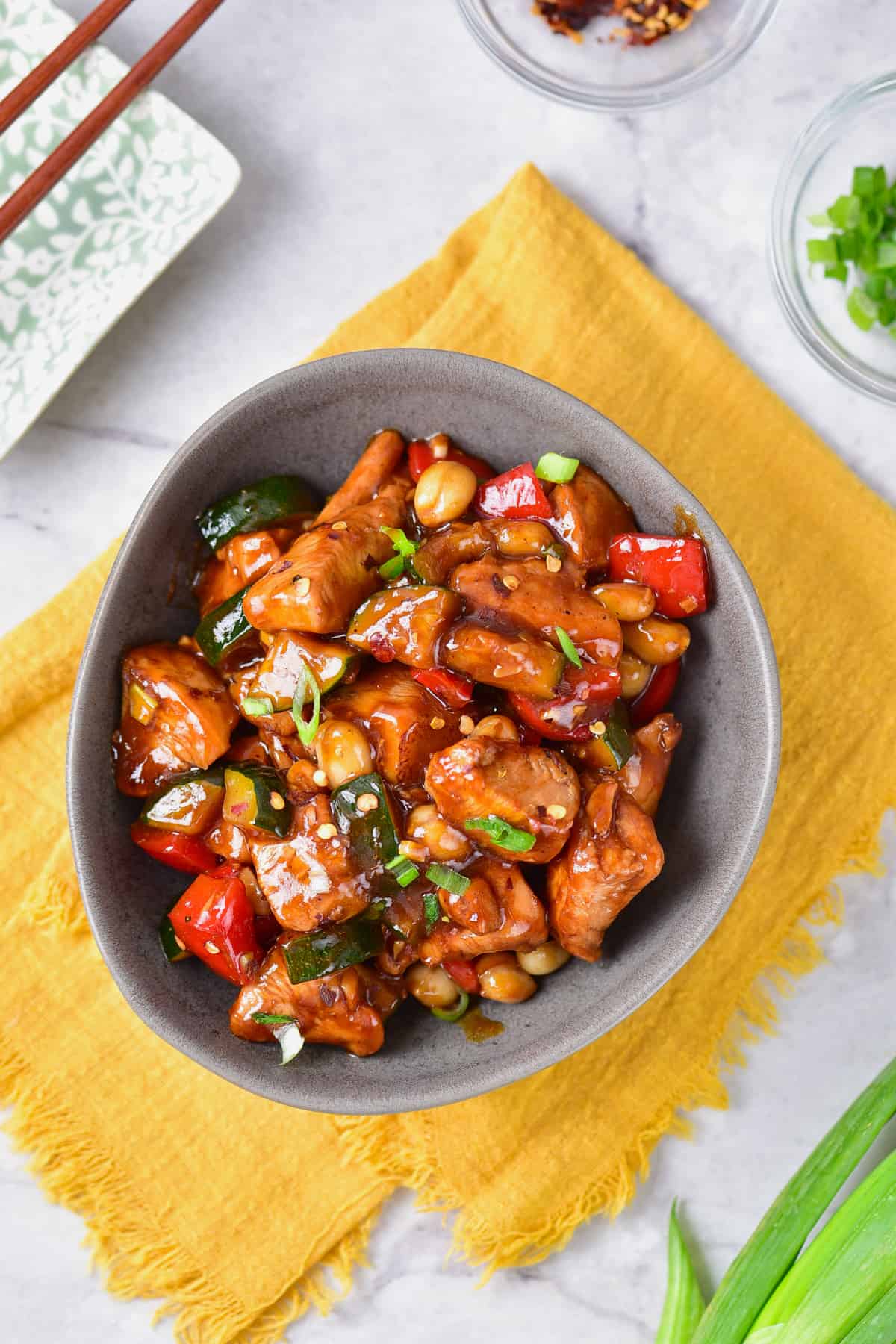
Email me the recipe!
Plus get all our new recipes too!
Have you ever found yourself craving that bold and spicy kick from Panda Express Kung Pao Chicken? You're in for a treat! You don't have to drive to Panda Express to enjoy your favorite dish anymore. How awesome is that?
Your own kitchen is about to be transformed into a personal Panda Express because I'm going to share the secret of making an almost identical Kung Pao Chicken. What makes this dish so special?
It's a delightful combo of sautéed chicken, crunchy peanuts, and that mouth-watering sauce with just the right amount of zing.
Check out all my Asian inspired chicken dishes such as my Instant Pot Chicken and Broccoli, Coconut Curry Chicken, and my Air Fryer Chinese Chicken on a Stick, or my Air Fryer Stir Fry.
What is Kung Pao Chicken?
Kung Pao Chicken is a classic Chinese stir-fry dish served in many Chinese restaurants. It originates from the Sichuan province of China where spicy flavors abound.
Variations exist from region to region, but you'll usually find it make with chicken, peanuts, vegetables, and Sichuan peppercorns.
At Panda Express, this dish has been tailored to suit a wide audience, balancing spice with crowd-pleasing appeal. It's often served with a side of fluffy white or fried rice to complement the bold flavors.
Remember, the essence of Kung Pao Chicken lives in its sauce-a savory blend of soy sauce, garlic, ginger, and a hint of sweetness. It's a dance of ingredients you won't want to miss.
Why this recipe works
Balance of Flavors: Your taste buds are treated to the perfect harmony of sweet, sour, and spicy. The sweetness comes from hoisin sauce and sugar, the sourness is courtesy of vinegar, and the heat - well, that's the dried chili peppers' job.
- So Much Flavor: You'll love the crunch of the peanuts juxtaposed with the tender chicken pieces. Each bite delivers a satisfying crunch.
- Time Saving: You can whip up this dish quicker than takeout. In the time it would take to pick up an order, you've got a fresh meal right in front of you.
- Customizable Heat: You're in charge of the spice level. Add chili peppers to make this as spicy as you like.
- Versatility: Serve it over rice, noodles, or add more veggies for a different twist. Kung Pao Chicken plays well with many side dishes, giving you ample meal options.
- Healthier Option: Opt for cooking spray instead of oil to reduce fat and calories- when you cook, you're in control.
Ingredients
Scroll to the bottom of the post for precise amounts and printable recipe card.
- Boneless skinless chicken breast - boneless chicken thighs is a good substitute.
- Oil - for cooking the meat and veggies. Mild flavored oil such as peanut oil, vegetable oil, or canola oil are great choices.
- Zucchini - adds color and crunch. It's also easy to prep. Choose baby corn if preferred.
- Red bell pepper - adds color and crunch. You can use green bell peppers if you have that on hand.
- Peanuts - are traditional. But opt for cashews or walnuts if you prefer.
- Soy sauce - low sodium soy sauce is my preference.
- Brown sugar - honey or maple syrup can be subbed.
- White wine - rice wine vinegar can be substituted, or even some chicken broth.
- Oyster sauce - hoisin sauce can be used instead.
- Sesame oil - adds that expected nutty taste...don't skip it!
- Garlic - freshly chopped tasted best.
- Ginger - freshly chopped for the best flavor.
- Granulated sugar - for a touch of sweetness. Adjust to taste.
- Salt and black pepper - for seasoning the chicken.
- Corn starch - to thicken the sauce.
- Green onions, white rice, red pepper flakes - for serving.
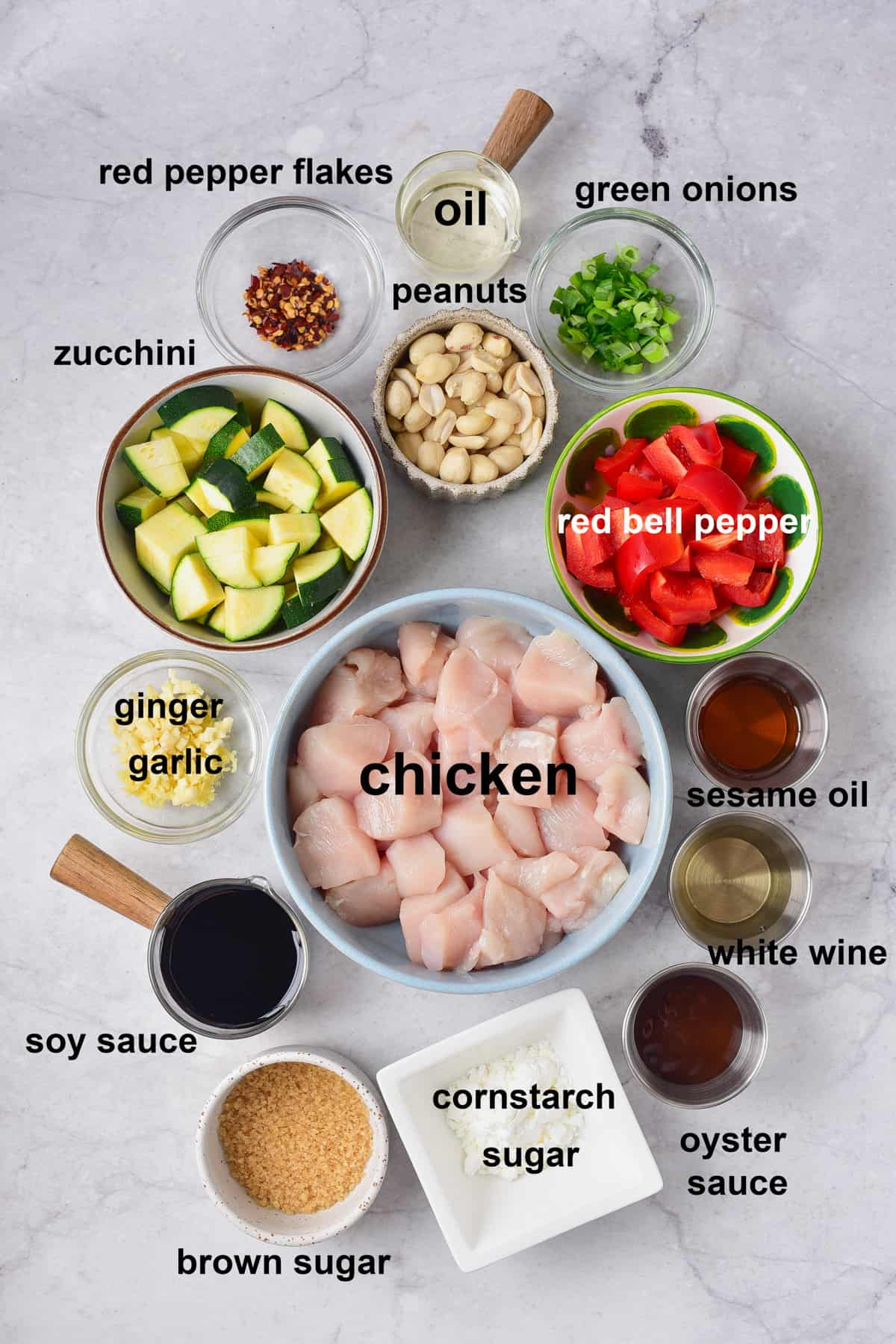
Directions
STEP ONE: Make the marinade: Mix 4 tablespoons soy sauce, brown sugar, and white wine in a small bowl and combine well with a whisk. Pour into a zip top bag (you can also just add the ingredients to a zip top bag. or marinate in the bowl). Add the chicken pieces to the marinade. Close the bag tightly being sure all pieces of chicken get coated. Marinate for at least half an hour in the refrigerator.
STEP TWO: While the chicken is marinating, prepare the vegetables and set aside.
STEP THREE: Heat 2 tablespoons oil in a large skillet or wok. Season chicken with salt and pepper then cook the chicken over medium-high heat until well seared on all sides, about 2-3 minutes. If chicken begins to burn, reduce heat to medium heat. Move the cooked chicken to a plate and set aside.
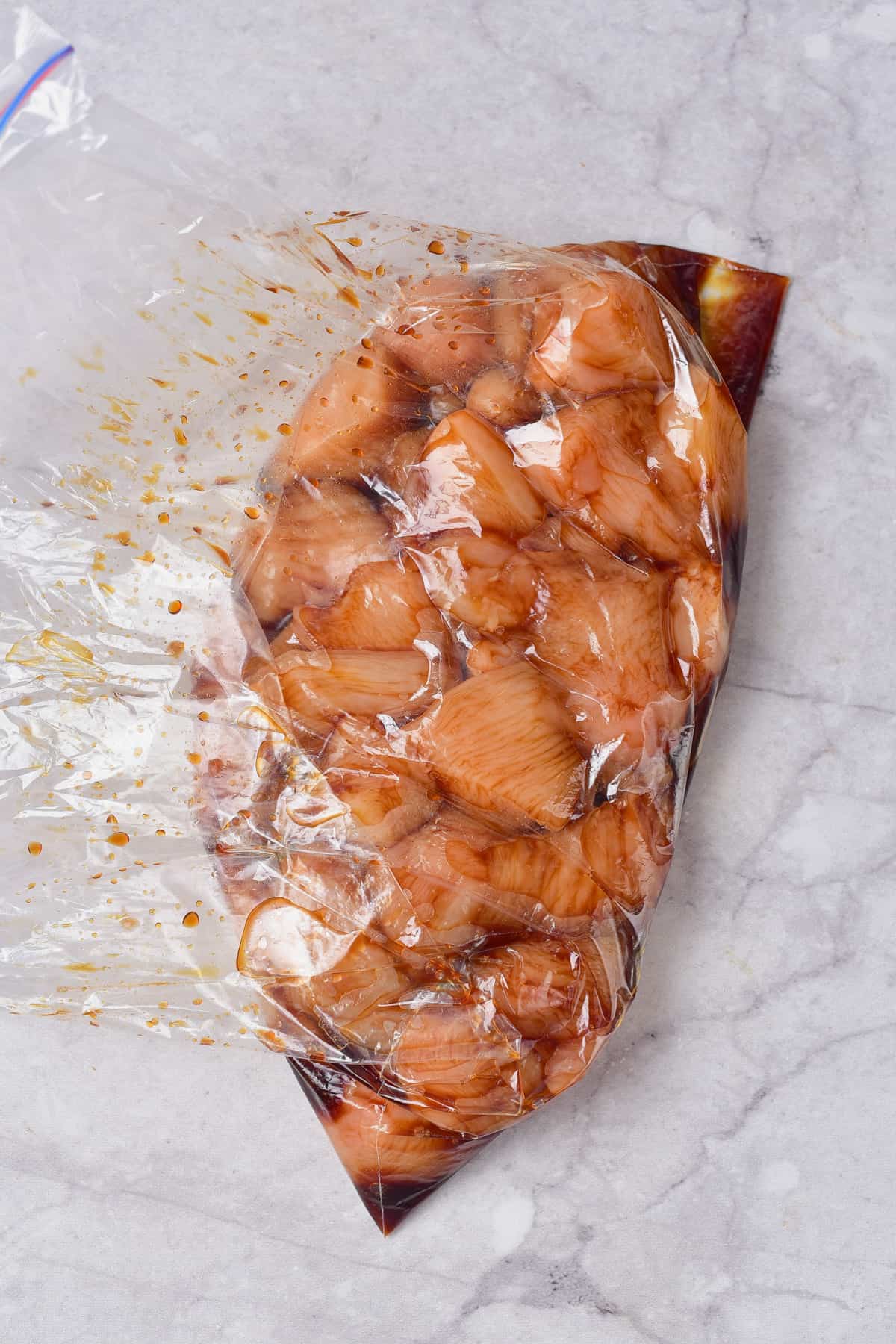
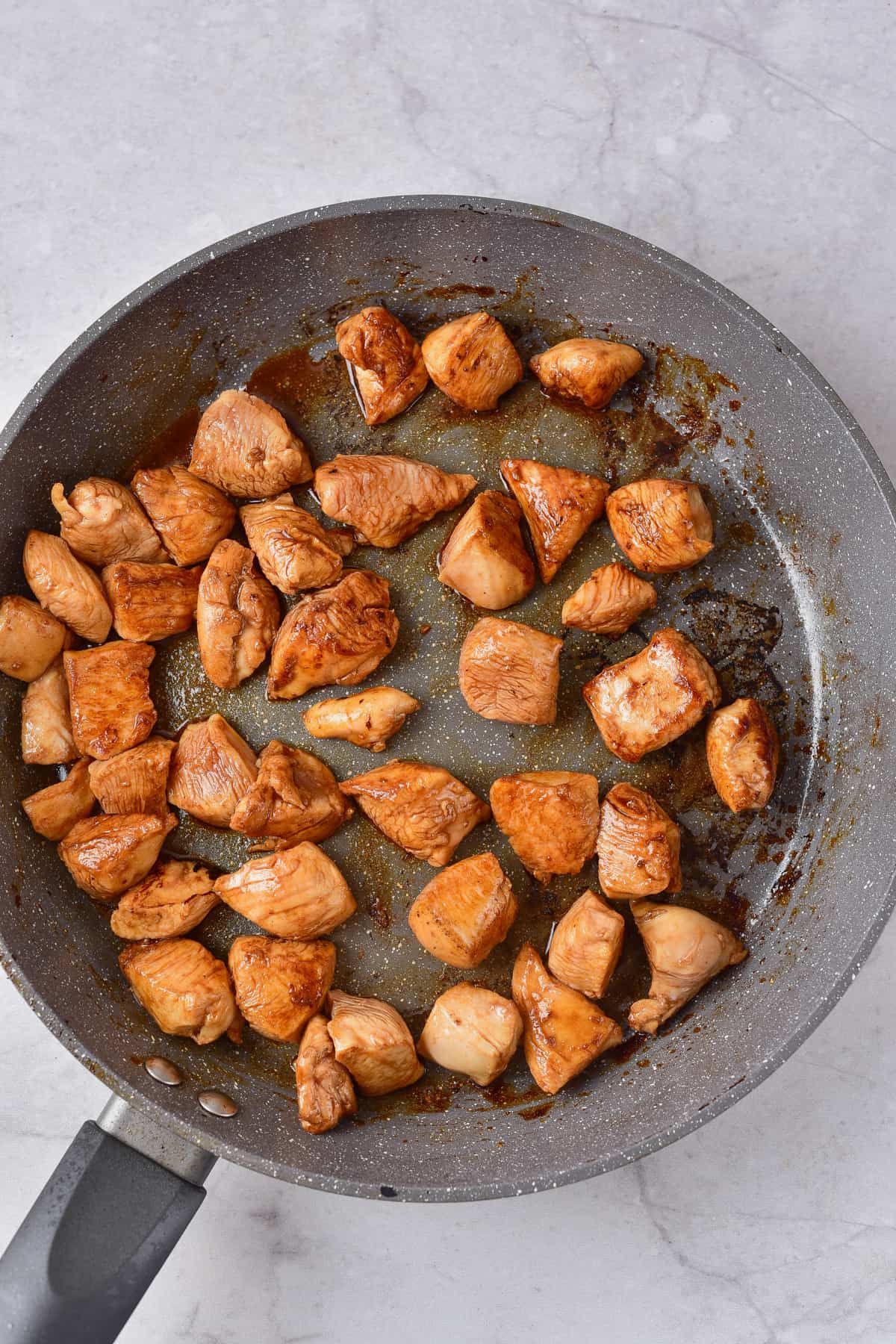
STEP FOUR: Make the stir fry sauce: Mix oyster sauce, 3 tablespoons soy sauce, sesame oil, chopped garlic, minced ginger, and sugar together in a small bowl. In a separate bowl, dissolve corn starch with 2 tablespoons of water and then add it to the sauce, stirring to combine well. Set aside while you cook the vegetables.
STEP FIVE: If necessary, add more oil to the pan and set heat to medium-high. Add sliced peppers, zucchini, and peanuts on medium heat until crisp-tender, about 2 minutes.
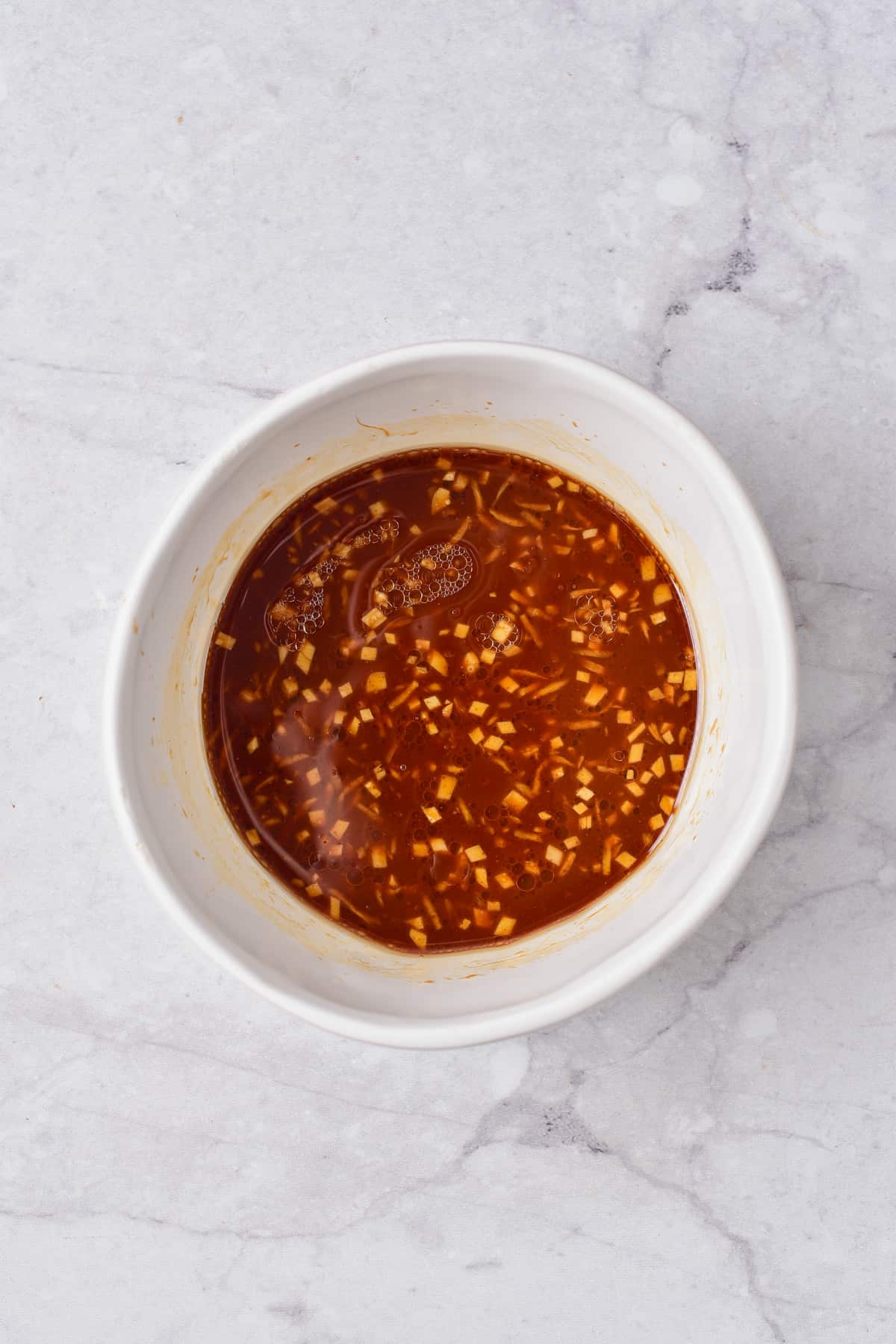
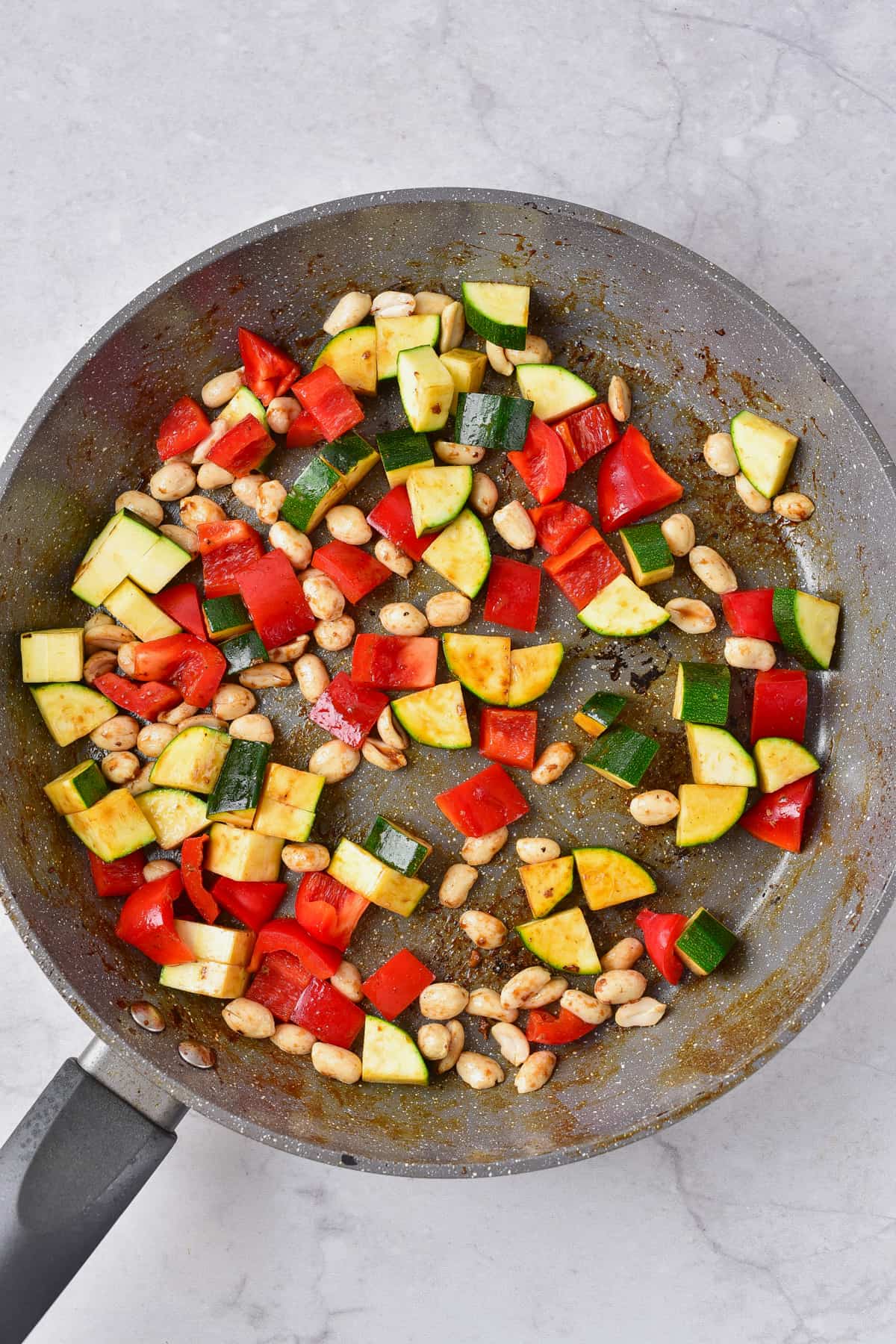
STEP SIX: Return the cooked chicken to the pan and cook everything together for another 1-2 minutes.
STEP SEVEN: Pour the sauce into the pan and stir it with the chicken and vegetable mixture. Cook over low heat for about 5 minutes or until sauce is thickened and glossy and chicken is cooked to 165 degrees F.
Serve Kung Pao chicken topped with green onions, chili flakes, and hot cooked rice.
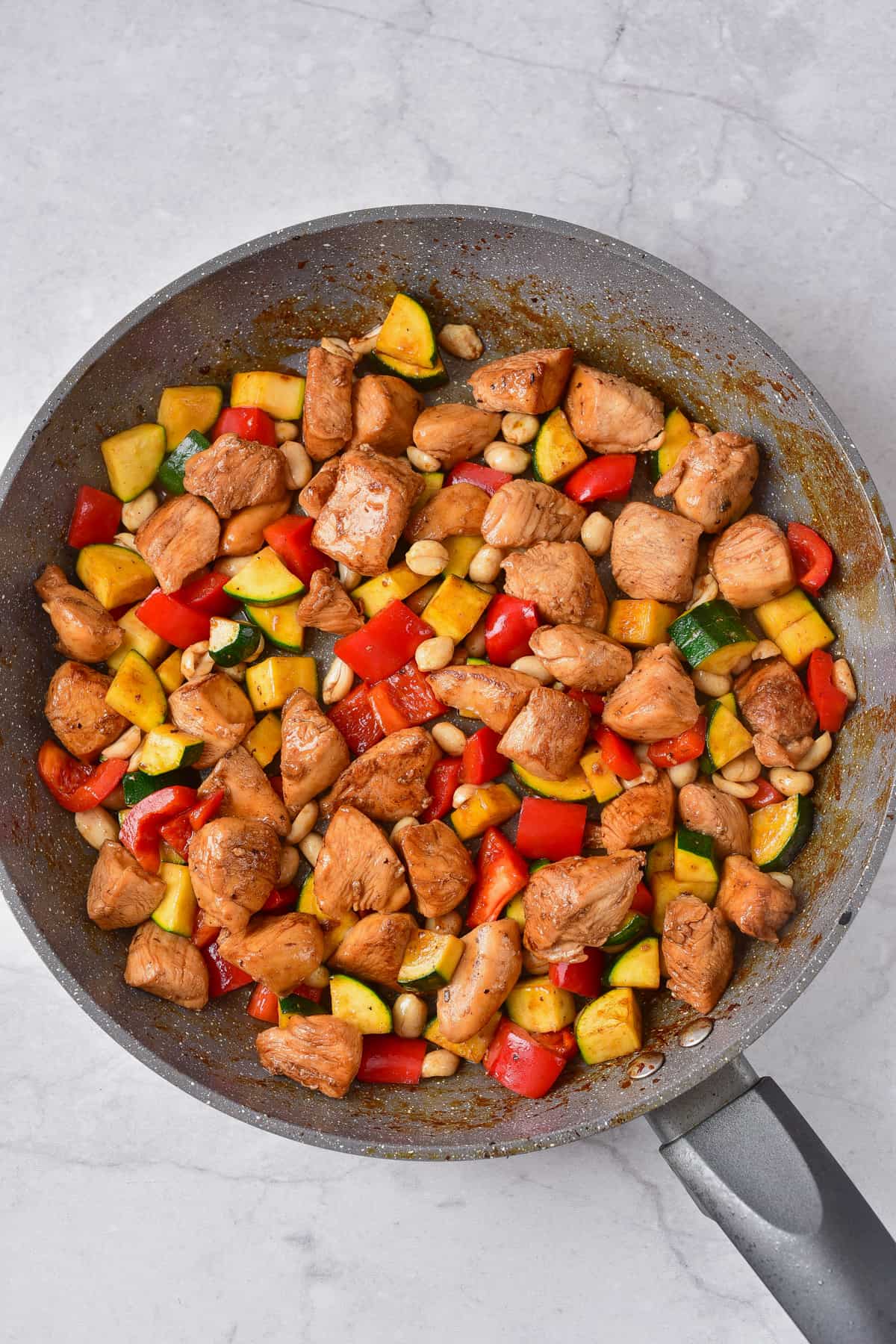
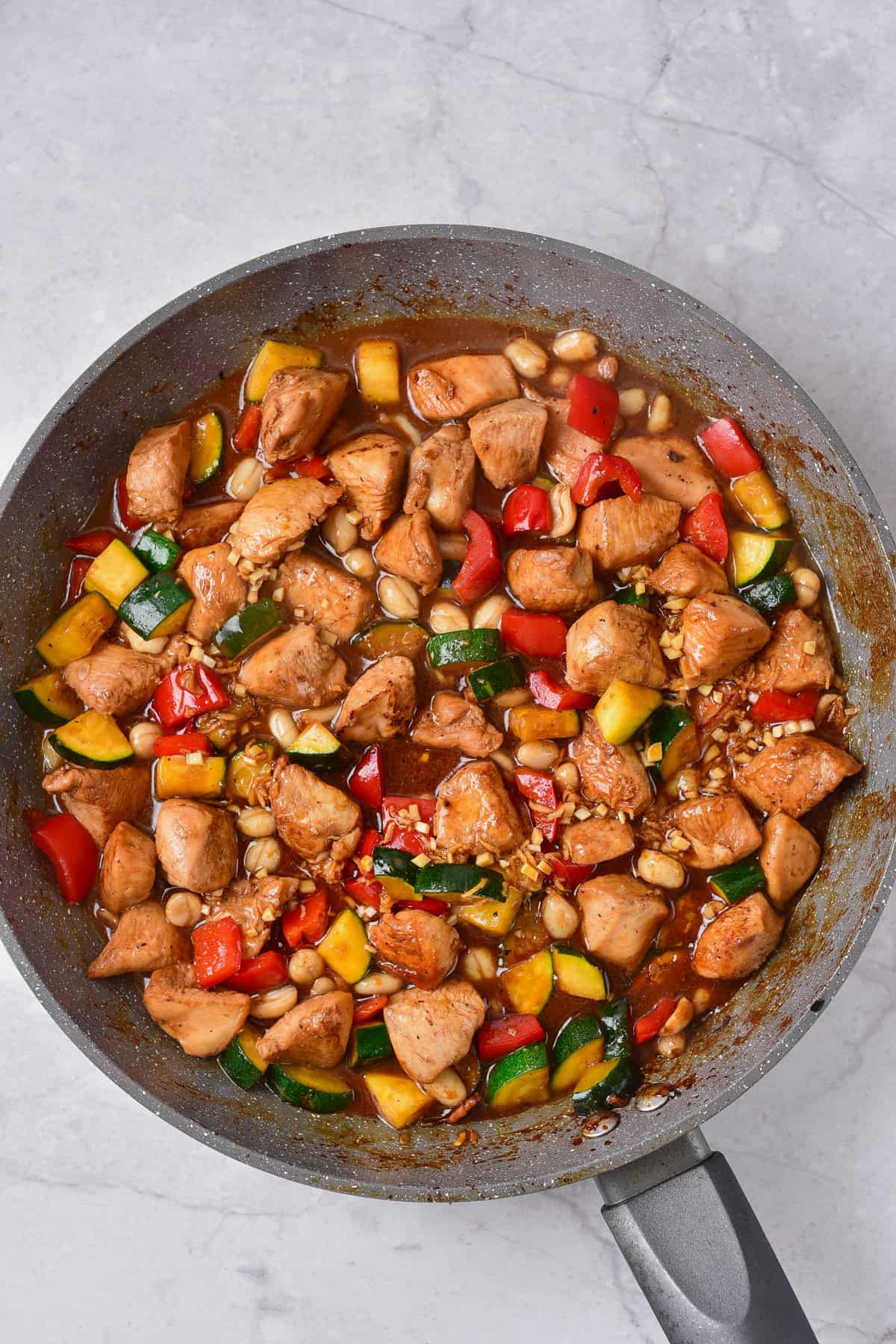
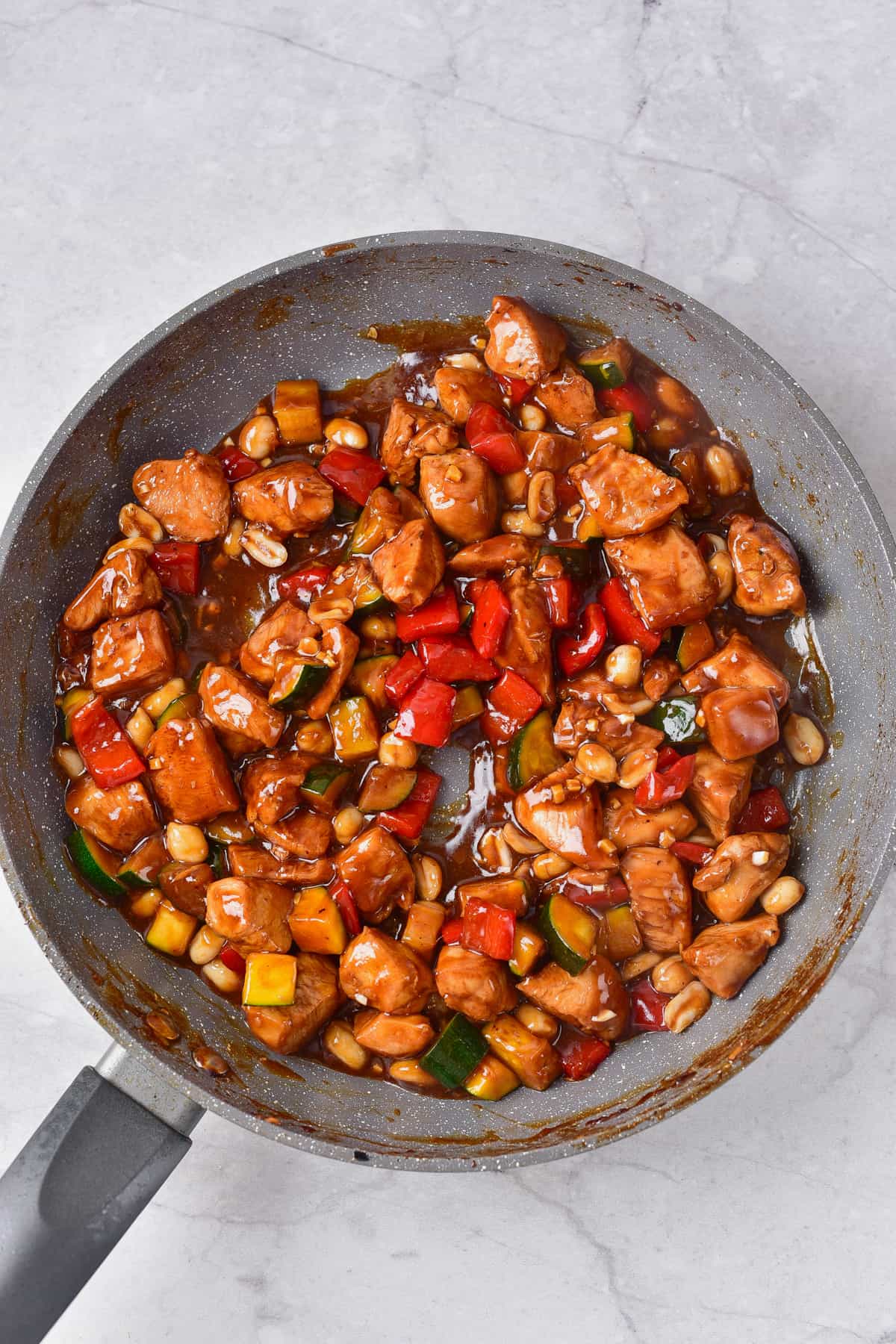
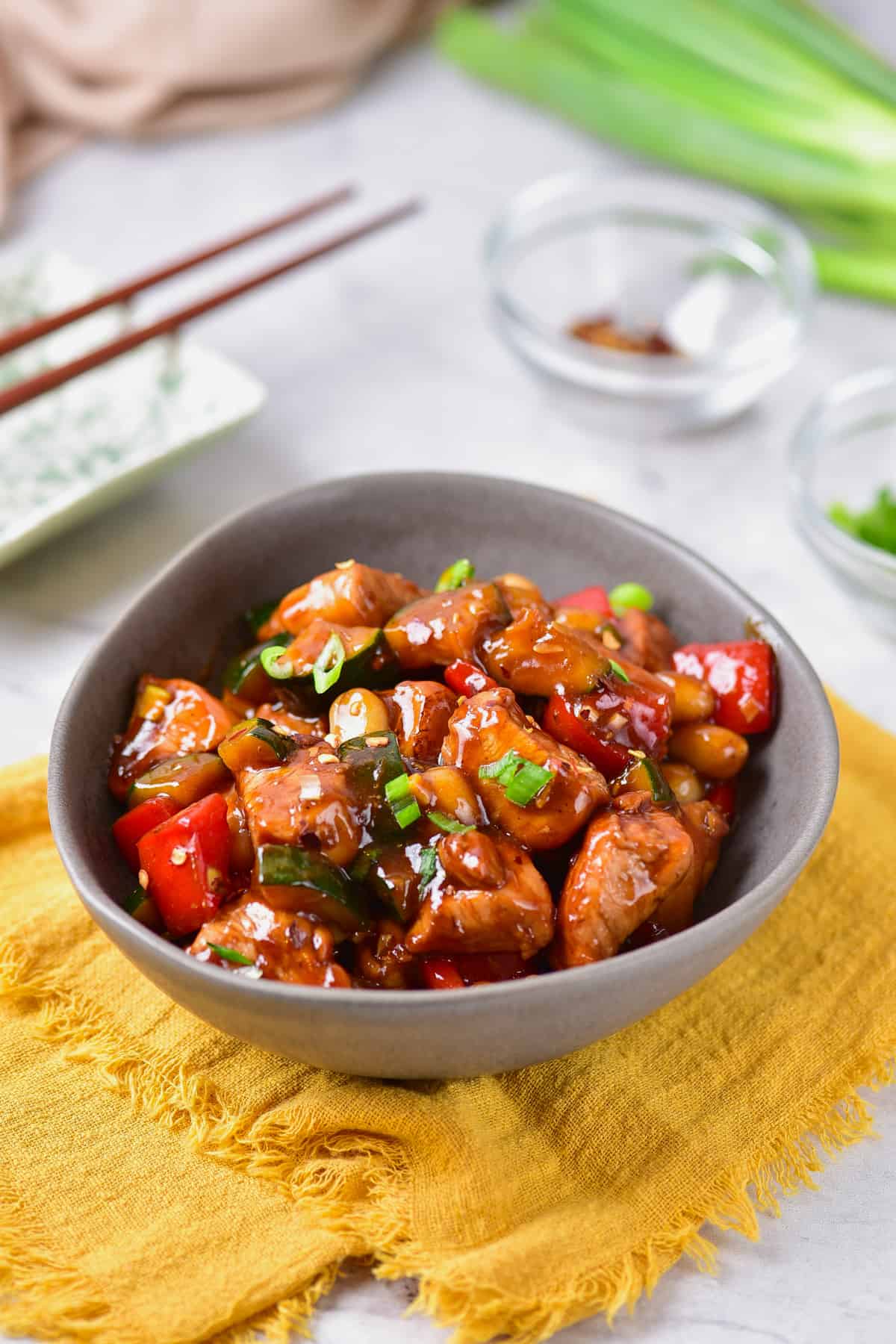
Cooking Tips
- Chop veggies uniformly: Keep your bell peppers and zucchini the same size for even cooking.
- High heat is your friend: Crank up the heat to get a good sear on the chicken and to keep veggies from getting watery.
- Stir frequently: Moving the ingredients around constantly will prevent burning and ensure everything cooks evenly.
- Consistency is key: Mix your sauce ingredients (soy sauce, vinegar, sugar, and water) in a bowl beforehand. This helps avoid a lumpy sauce situation.
- Taste as you go: Don't be shy to tweak the sweet and savory levels to your liking before adding the sauce to the pan. You can add more or less sugar and soy sauce to adjust to your liking.
Storage and Reheating
When you've had your fill of Kung Pao Chicken and you're stuffed with all that spicy goodness, it's time to stash the leftovers. Pop it in an airtight container and slide it into your fridge. It'll stay good for about 3 to 4 days-just enough time to relive those flavors!
To reheat, you've got options:
- Microwave: Zap it on high for 90 seconds, stir, and repeat if necessary. Cover it with a microwave-safe lid to avoid splatter.
- Stovetop: In a pan over medium heat, add a splash of water or chicken broth. Stir occasionally until it's heated through.
Not in the mood to eat it soon? Freeze it! Just make sure it's cool before you do. In a freezer bag or suitable container, it'll be good for 2 to 3 months. But remember, the quicker you eat it, the better it'll taste when thawed.
Thawing out:
- Refrigerator: Overnight is best to keep the texture in check.
- Microwave: Use the defrost setting before reheating it if you're in a hurry.
Quick tip: Sprinkle a little water over the top before reheating to keep the chicken juicy!
Common questions and answers
Your Kung Pao Chicken will typically feature diced chicken breast as its starring protein.
Absolutely! Swap chicken for tofu or a mix of your favorite veggies.
Crunchy roasted peanuts are the nuts you'll find adding texture to the dish.
Recipe Variations
When you're experimenting with the iconic Kung Pao Chicken from Panda Express, feel free to tweak things to suit your taste! Let's look at a couple of ways to make this dish truly yours.
Veggies: If you want to add more color and crunch to your meal, toss in some vibrant veggies like broccoli or snow peas. They not only add a pop of color but also an extra dose of nutrition.
Protein Swap: Chicken is classic, but why not try tofu for a vegetarian twist, or shrimp for a different flavor of seafood? Remember, cooking times may vary!
- Tofu (firm, cubed) - pan-fry separately before adding to the sauce.
- Shrimp (peeled and deveined) - cook until they turn pink and opaque.
Heat Level: Prefer a spicy dish? Add a teaspoon of your favorite chili paste or sauce to the sauce ingredients. Try sriracha, chili garlic sauce, or just a pinch or two or crushed red peppers. Choose your heat level so it's perfect for your tastebuds.
Kung Pao chicken tastes great with these recipes
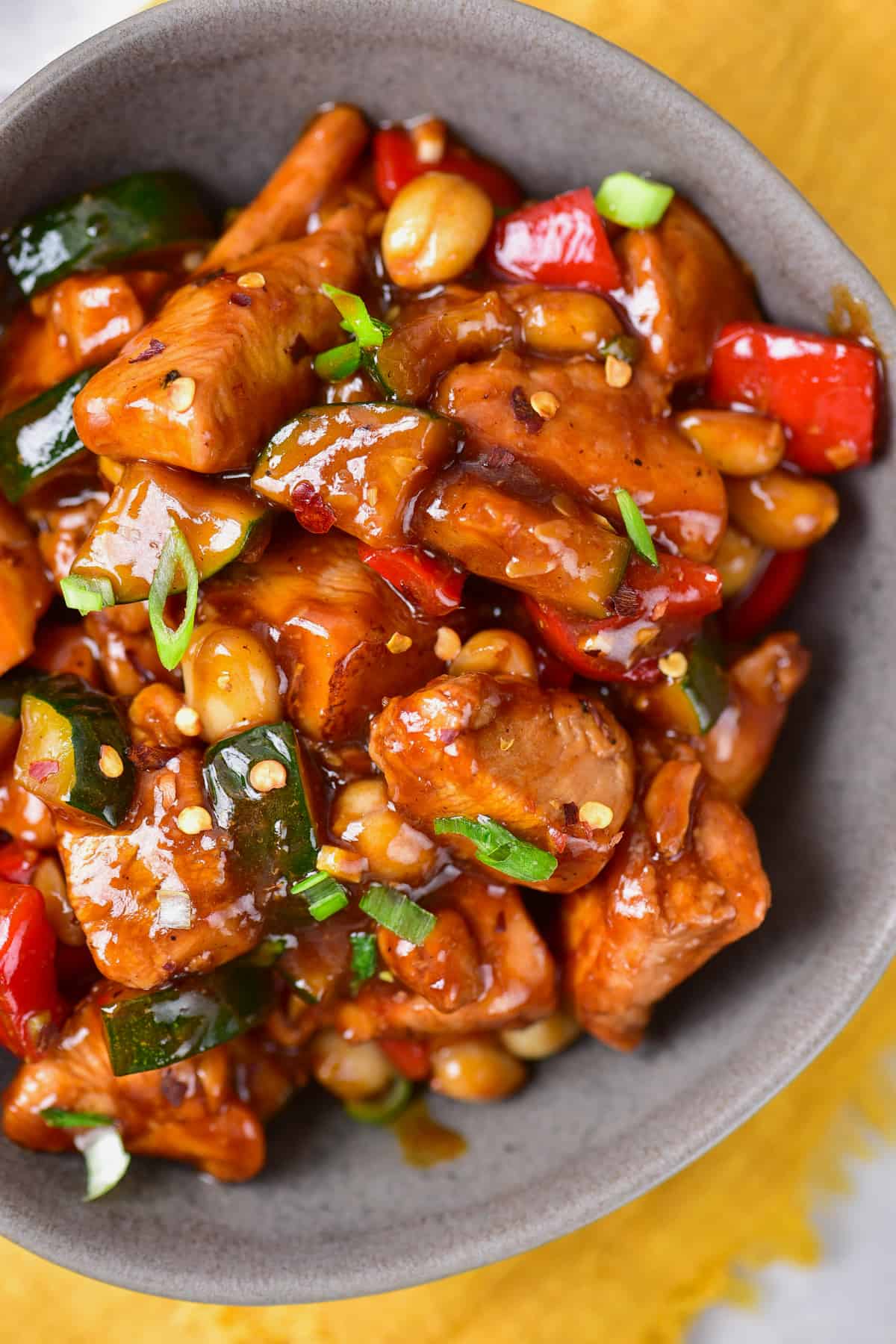
Thank you for checking out this Panda Express Kung Pao Chicken copycat recipe. I'm grateful to have readers like you! If you enjoyed the recipe, I'd love a star rating and any feedback you may have. Please come back to The Travel Palate for more recipes made with maximum flavor and minimal effort!
Email me the recipe!
Plus get all our new recipes too!
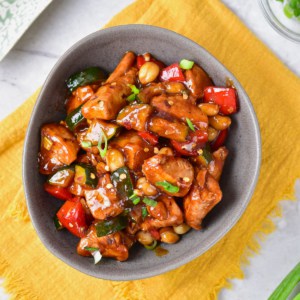
Panda Express Kung Pao Chicken
Ingredients
Marinade
- 2 cups boneless skinless chicken breast diced into bite sized pieces, about 1.5 lbs.
- 4 tablespoon soy sauce
- 1 teaspoon brown sugar
- 3 tablespoon white wine
Stir Fry
- 2 tablespoon frying oil
- 1 zucchini diced
- 1 red pepper diced
- 3 tablespoon peanuts
Sauce
- 3 tablespoon oyster sauce
- 3 tablespoon soy sauce
- 2 tablespoon sesame oil
- 2 teaspoon chopped garlic
- 2 teaspoon minced ginger
- 1 teaspoon sugar
- 1 tablespoon cornstarch
- 2 tablespoon water
Garnish
- 1 tablespoon chili flakes for serving
- 3 tablespoon chopped green onions for serving
- 2 cups hot cooked rice
Instructions
- Make the marinade: Mix 4 tablespoons soy sauce, brown sugar, and white wine in a small bowl and combine well with a whisk. Pour into a zip top bag (you can also just add the ingredients to a zip top bag, or marinate in the bowl). Add the chicken pieces to the marinade. Close the bag tightly being sure all pieces of chicken get coated. Marinate for at least half an hour in the refrigerator.
- While the chicken is marinating, prepare the vegetables and set aside.
- Heat 2 tablespoons oil in a large skillet or wok. Season chicken with salt and pepper then cook the chicken over medium-high heat until well seared on all sides, about 2-3 minutes. If chicken begins to burn, reduce heat to medium heat. Move the cooked chicken to a plate and set aside.
- Make the sauce: Mix oyster sauce, 3 tablespoons soy sauce, sesame oil, chopped garlic, minced ginger, and sugar together in a small bowl. In a separate bowl, dissolve corn starch with 2 tablespoons of water and then add it to the sauce, stirring to combine well. Set aside while you cook the vegetables.
- If necessary, add more oil to the pan and set heat to medium-high. Add diced peppers, zucchini, and peanuts on medium heat until crisp-tender, about 2 minutes.
- Return the cooked chicken to the pan and cook everything together for another 1-2 minutes.
- Pour the sauce into the pan and stir it with the chicken and vegetable mixture. Cook over low heat for about 5 minutes or until sauce is thickened and glossy and chicken is cooked to 165 degrees F.
- Serve Kung Pao chicken topped with green onions, crushed red chili flakes, and hot cooked rice.
Notes
- Chop veggies uniformly: Keep your bell peppers and zucchini the same size for even cooking.
- High heat is your friend: Crank up the heat to get a good sear on the chicken and to keep veggies from getting watery.
- Stir frequently: Moving the ingredients around constantly will prevent burning and ensure everything cooks evenly.
- Consistency is key: Mix your sauce ingredients (soy sauce, vinegar, sugar, and water) in a bowl beforehand. This helps avoid a lumpy sauce situation.
- Taste as you go: Don't be shy to tweak the sweet and savory levels to your liking before adding the sauce to the pan. You can add more or less sugar and soy sauce to adjust to your liking.

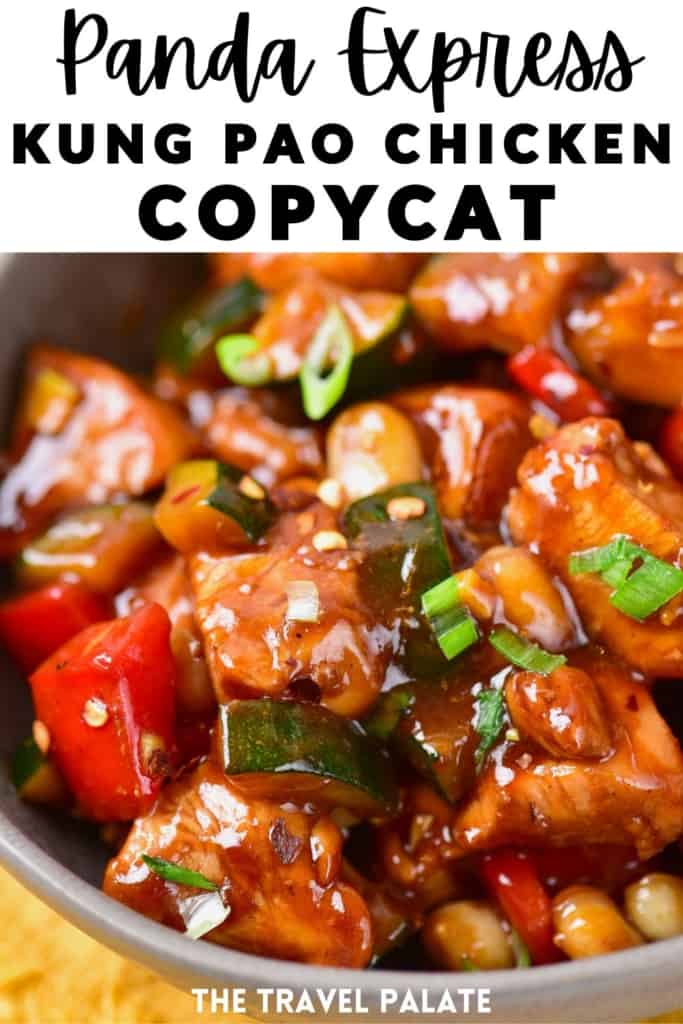
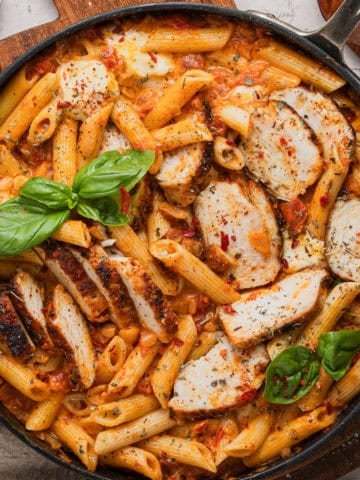
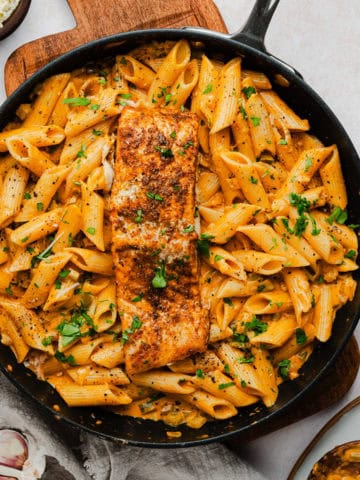
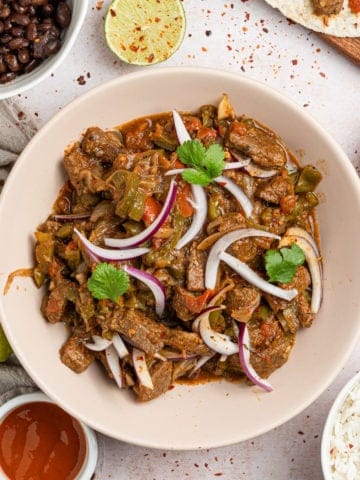
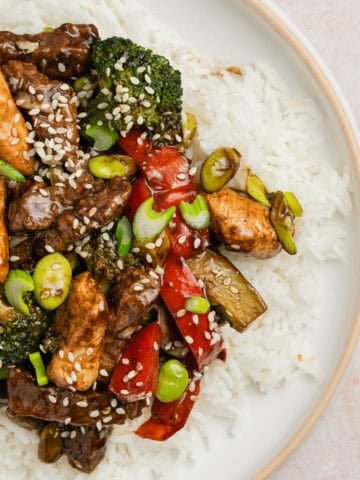
Jenilynn Frizell says
Delicious! Added some Arbol peppers to quick up the heat!
Nikole Berg says
So glad you enjoyed the recipe, Jenilynn! Thank you for your feedback and helpful tip!
Teri Scully says
Delicious. I have made it twice. Great recipe!
Nikole Berg says
I'm so glad you loved it Teri! Thank you for your feedback and 5 stars!!